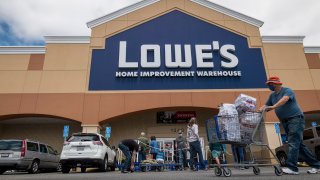
- Lowe's said fourth-quarter same-store sales climbed 28.1%, as consumers spent more on home projects during the pandemic.
- Same-store sales climbed 28.1%, outpacing estimates that called for a 22% gain.
- Lowe's reiterated its prior forecast, which says spending on DIY projects and home improvement could ease as consumers resume normal activities post-pandemic.
Lowe's said Wednesday its fourth-quarter same-store sales climbed 28.1%, as consumers spent more on home projects during the pandemic.
That's higher than the 22% growth that analysts expected, according to StreetAccount. Even with the strong results, Lowe's continues to expect that sales could moderate as the pandemic eases.
The company's shares closed down 3.72% to $162.31. As of Wednesday's close, the company's market value is $118.93 billion and its shares are up about 32% over the past year.
Get San Diego local news, weather forecasts, sports and lifestyle stories to your inbox. Sign up for NBC San Diego newsletters.
Here's what the company reported for the quarter ended Jan. 29 compared with what Wall Street was expecting, based on a survey of analysts by Refinitiv:
- Earnings per share: $1.33 adjusted vs. $1.21 expected
- Revenue: $20.31 billion vs. $19.48 billion expected
Lowe's reported fourth-quarter net income of $978 million, or $1.32 per share, up from $509 million, or 66 cents per share, a year earlier.
Money Report
Excluding items, it earned $1.33 per share, exceeding the $1.21 per share expected by analysts surveyed by Refinitiv.
Net sales rose to $20.31 billion, outpacing analysts' expectations of $19.48 billion.
Sales at its U.S. stores open at least a year and online grew by 28.6% in the quarter.
'Not an anomaly'
Lowe's has gained customers and gotten a boost in sales during the pandemic, as Americans have done do-it-yourself projects and caught up on home repairs while stuck at home. The global health crisis also struck at a time when the retailer was in the middle of a turnaround effort, which has included a website redesign, supply chain investments, store improvements and a plan to win the business of more home professionals, such as contractors and electricians.
CEO Marvin Ellison said its soaring sales throughout the year reflect those strategic decisions, not just stay-at-home trends.
"We believe that 2020 was not an anomaly," he said, adding that it plans to gain market share even as the pandemic wanes.
In the fourth quarter, Ellison said the company saw high demand across the board. Sales grew 16% in all merchandising departments and more than 19% in all regions of the country. Online sales grew by 121%.
Accelerating sales growth
The retailer saw higher-than-usual interest in buying Christmas trees and other seasonal nursery items like poinsettias. It also reported strong sales of grills, patio heaters and firepits as consumers spent more time outside, even as temperatures dipped.
Chief Financial Officer Dave Denton said Lowe's quickly pivoted from the holidays to special events focused on home organization and bath to continue to drive sales in January. He said growth of sales online and at stores open at least a year in the U.S. accelerated each month of the quarter, with 23.8% in November, 28% in December, and 35.7% in January.
The company said momentum has continued in February.
Lowe's, however, reiterated its previous forecast and cautioned home improvement demand will taper off in the months ahead. At an investor day in December, Denton had said sales will likely decline in 2021 as more people get Covid-19 vaccines and spend more time outside their homes.
He laid out three scenarios for a robust, moderate or weak market. In a robust market, the retailer's outlook for 2021 anticipates a 5% to 7% drop in demand for the home improvement sector on a mix adjusted basis. In a moderate and weak market, demand would likely drop respectively by 7% to 9% and 10%.
Even in a weak market, Denton said, the retailer is poised to improve its operating margins. He said as sales moderate with do-it-yourself customers, they may pick up with home professionals — a smaller part of Lowe's customer base, but one that it's looking to grow.
On a call with investors and analysts on Wednesday, Denton said trends currently point to the robust market scenario. The scenario predicts that Lowe's sales for the year would be around $86 billion — a drop-off from its net sales of approximately $89.6 billion in 2020.
Holding on to new customers
Jefferies analyst Jonathan Matuszewski said he is betting on the company's robust market scenario, too. He said more consumers have gotten comfortable with taking on do-it-yourself projects, a pattern they will likely repeat. The firm gives Lowe's a buy rating, with a target price of $207. That would represent a 20% gain from where shares are currently trading.
He pointed to industry surveys, which report that more than 20% of respondents that did DIY projects last year used a drill for the first time. The survey also reflected a more balanced mix of women and men customers taking on the projects.
"We believe the entry of new Americans into the world of DIY projects builds the case for Lowe's as they lap challenging comparisons in F'22," he said in the research note. "Additionally, we think investors underappreciate the sense of accomplishment DIYers felt from newly-acquired skills during the pandemic and what that implies for propensity to tackle future (more complex) projects."
Fading pandemic trends could test whether Lowe's has lasting loyalty among its newer customers, too.
Neil Saunders, managing director of GlobalData, said consumers are starting to return to old habits, like going to stores they prefer instead of ones that are closer or more convenient. As that happens, he said Lowe's could lose some shoppers to larger retailer and competitor, Home Depot.
Home Depot's fourth-quarter earnings also surpassed Wall Street's expectations this week. The retailer reported strong demand for DIY project supplies, outdoor items like patio furniture and holiday decor as shoppers spend more time at home. However, it did not provide an outlook for the year, saying it wasn't sure how long the pandemic will last and what that means for consumer spending.
Both retailers are likely to see higher costs for as long as the health crisis lasts. In its earnings report, Lowe's said it spent more than $100 million in the fourth quarter and more than $900 million for the year on additional Covid-related pay and benefits for employees. It said it spent nearly $1.3 billion in pandemic-related expenses, including higher wages and store safety measures in the fiscal year.
The company said it spent $3.4 billion on share buybacks and paid $452 million in dividends in the fourth quarter.
Read the complete press release here.






